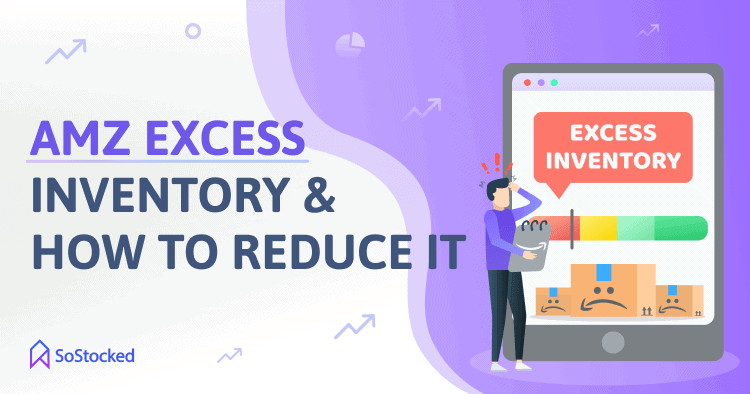
Amazon Excess Inventory: Why It’s Bad and How to Reduce It
Every seasoned seller has likely ended up with Amazon excess inventory at some point. The reason may be overestimating demand or sellers fixating on their top-selling products while ignoring those that aren’t making as many sales. Therefore, they end up gathering dust in a warehouse for months.
However, fixating on products that generate most of the income may also mean overlooking the costs of carrying excess stock. These costs may include storage fees, damage or spoilage losses, insurance, labor and facility expenses, penalties, and so on. When money is unavailable for other essential uses, such as marketing and advertising, it reduces your ability to generate profit as well, also known as opportunity cost.
If you are losing cash this way, it’s time to create a new game plan to keep your inventory moving.
In this Amazon Excess Inventory guide, we’ll take a look at:
What Is Amazon Excess Inventory?
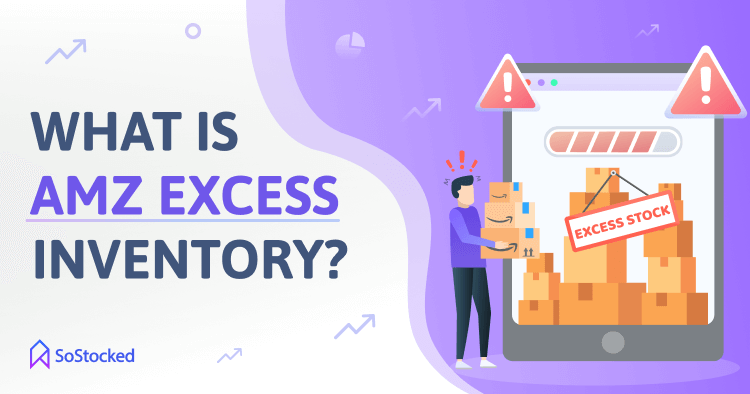
Excess inventory is an overstocked amount of inventory that has yet to be used or sold. Therefore, they remain in storage, facing the inevitable decline in value while accumulating unnecessary holding costs.
Amazon identifies an inventory as potentially excess if:
- At least one unit of your inventory is more than 90 days old
- The product has more than 90 days’ worth of supply
- The cost associated with holding your inventory without taking any action is higher than the cost of taking action (e.g., putting the excess units on sale to boost sell-through or removing them)
How does Amazon calculate estimated excess quantity?
Amazon determines your number of excess units based on your sales data, cost of inventory, and turnover rate. You can update these data within your Seller Account to help Amazon to make more accurate recommendations on how to best handle your Excess Inventory.
Factors used by Amazon include the unit cost and recovery rate (the percentage of the total inventory purchase that you can recover through non-sales, cost-recovery channels such as liquidation or buy-back contract clauses), sales data (e.g., price elasticity and demand forecasts), among other economic inputs.
Beyond the 90-day inventory age, the estimated quantity of excess stock refers to the number of units for which the cost of holding your excess inventory without taking action would be greater than the cost of taking action. This value is based on the following factors:
- Demand for the product
- Fees
- Cost of capital
- Unit costs
This value also estimates the most optimal inventory level at which you could get the highest return on investment. However, one fault in this system is that the settings apply to all inventory across the board, so if you have a great discrepancy between products, the accuracy of these calculations could be skewed.
Note: You can find listings that may have overstock inventory levels from Amazon’s Manage Excess Inventory page. This tool gives you relevant information about your surplus inventory so you can take action ASAP and improve your sell-through rate.
Inventory Turnover Ratio
Inventory turnover ratio (ITR) is the rate at which your business sells and replenishes stock in a given period. It’s another way to gain insights into your inventory management efficiency, i.e., whether you’re holding excess stock or stocking out too often. By keeping track of your ITR, you can effectively plan against these problems.
You can calculate your ITR by:
- Finding your total Cost of Goods Sold (COGS) from your financial statements.
- Calculating your average inventory by adding your beginning inventory (e.g., the start of the month) and ending inventory (e.g., the end of the month) together and then dividing the sum by two.
- Lastly, by dividing your COGS by average inventory.
COGS Formula
Beginning Inventory + Purchases During Period – Ending Inventory = COGS
A turnover ratio lower than the industry benchmark indicates you’re carrying many excess units that have yet to be used or sold. In contrast, an exceptionally high ITR could mean you’re encountering stockouts more often than usual or your shipping could be consolidated for better efficiency and profitability.
Pro Tip: Learn more about inventory turnover with Amazon Inventory Turnover: Understand, Calculate, and Automate.
Why Is It Bad To Have Too Much Inventory?
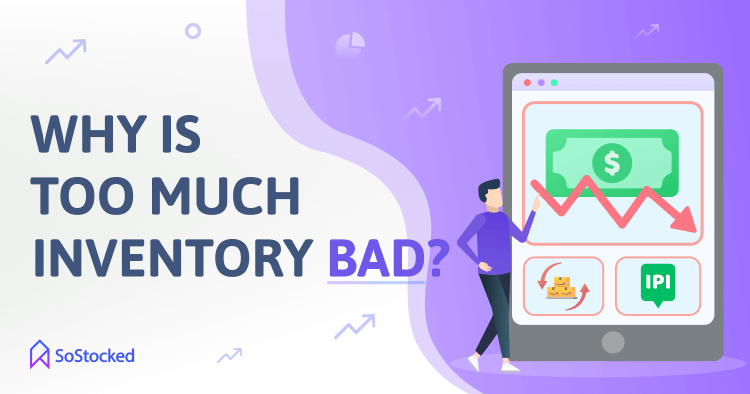
Holding too much inventory has costly consequences and challenges. Among the priciest are:
Lower Amazon IPI score
The Amazon Inventory Performance Index (IPI) measures the overall efficiency in inventory management within your FBA business. This metric tells you how efficient you are at maintaining good inventory levels and sales, keeping top sellers in stock, and solving listing issues that make your products unavailable to customers.
A 500 IPI score or above means your FBA inventory is performing satisfactorily. You will also no longer be subject to Amazon’s storage limitations for inventory in oversize, standard-size, clothing or footwear.
Conversely, depending on Amazon’s most current guidelines, a score between 350-499 could mean Amazon placing limits on your FBA storage. And if you have any aging inventory, it could also lead to long term storage fees.
Two scoring factors that Amazon uses to determine your IPI score are:
- Excess inventory percentage
- Sell-through rate
If you have too much stock on hand, it means you’re not converting that inventory into sales as quickly as you should be (within 90 days for Amazon sellers). This issue may result in a lower sell-through rate, which signals to Amazon that your inventory isn’t performing well. Thus, you may receive a lower IPI score, leading to reduced storage limits.
Pro Tip: Improve your Amazon IPI score with 4 Ways to Improve Your Amazon IPI Score + IPI Updates.
Storage Limits Clogged with Non-Moving Products
With the new Amazon storage-type limits imposing account wide restrictions on storage, more excess slow-moving inventory means less FBA storage space for your top-sellers, something which can lead to stockouts. Stockouts, in turn, lead to lower limits and you find yourself in a dwindling spiral of lower and lower limits and a stockout cycle that can become hard to recover from.
Clearing excess stock from the FBA warehouses means you have more room for those sellers that absolutely must stay in stock.
Lower Amazon Rankings
Most Amazon businesses generate 80% of their profit from 20% of products or top sellers. That’s why slow sellers get less attention, in that they may have outdated or poorly optimized product pages.
This practice isn’t ideal because Amazon uses a search engine algorithm called A9, which ranks products based on relevance (keyword-rich title, bullet points and description) and performance (conversion).
When a product page or listing isn’t optimized for these two crucial ranking factors, it is less likely to show up at the top of Amazon search results, resulting in less traffic and fewer sales. Therefore, the units end up unsold, tying up your capital in inventory carrying costs.
Lower Inventory Turnover Ratio
As mentioned earlier, your inventory turnover ratio indicates how well you manage your inventory. If you’re not moving the units in that inventory as quickly as possible, they will deteriorate or decline in value over time, essentially leaving you with obsolete products. If no action is taken immediately, this excess inventory situation may appear as a low inventory turnover ratio in your annual income statement. A less-than-ideal ITR may turn off potential investors and creditors.
Adversely Affects Cash Flow
How you manage your Amazon overstock inventory will have a direct impact on your business’s cash flow.
If you fail to move excess stock quickly, you will incur unnecessary fees on top of your monthly storage fees. And the more unsold inventory you keep at your FBA warehouse, the more you pay every month. Additionally, there are penalty fees involved in storing inventory with Amazon for six months or more. After one year, that penalty grows even greater, and extra fees can add up quickly. Additionally, storage costs in the last quarter of the year are about six times higher than average so having excess inventory during this time can be painful.
When your capital is tied up in these holding costs, a certain amount of money becomes unavailable for other core aspects of your business.
Increased Opportunity Cost
In retail, opportunity cost refers to the value of inventory you could have purchased and sold instead of the one sitting in your warehouse. That’s why you must put your Amazon excess inventory on sale or liquidate it to not only improve your sell-through rate but also keep your opportunity cost under control.
Increased Risk of Product Deterioration and Obsolescence
Most products lose their value over time, especially those that evolve very fast, like electronic gadgets. While it’s a good thing for customers who always want the newest, it also means electronic products can quickly become out of trend, or worse, obsolete once they enter the final phase of their life cycle. That’s why sellers must generate highly accurate demand forecasts and communicate them to their suppliers to ensure they only produce enough inventory for the anticipated demand to avoid any Amazon excess inventory.
5 Common Causes Of Amazon Overstock Inventory
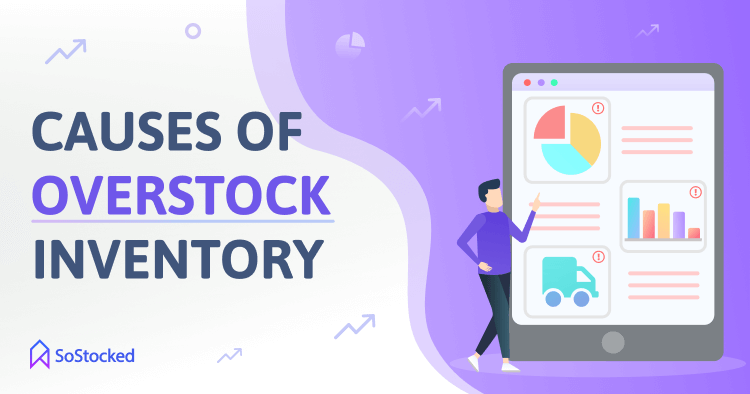
Overestimating demand forecasts
Inaccurate demand forecasts often lead to ordering too much or too little stock. This problem may be due to not having the correct tools for anticipating demand. For example, you’re not using a sophisticated demand forecasting program for complicated calculations like identifying and factoring out stockout days.
If you include days you stocked out in your calculations, you’re bound to make the same mistake again: under-ordering. And to prevent another stockout, you’ll order more stock, but perhaps the demand or sales trend has already passed before the next shipment arrives, so you’ll be left with excess inventory that you need to get rid of.
This is where SoStocked comes in handy. In SoStocked, you can do advanced stockout calculations. The software calculates stockouts based on whether or not you had inventory at an FBA center and analyzes for significant sales velocity drops. You will also be able to spot your low sales days pre and post-stock outs and during days when you’re out of stock and Amazon miraculously finds an extra unit to sell. Additionally, this advanced feature also helps you identify days of listing suspension that you should remove from your daily velocity calculation.
Pro Tip: Check out our product demo to learn more about SoStocked’s inventory forecasting features.
Poor inventory management
Inefficiency costs businesses up to 30% of their revenue yearly. In inventory management, inefficiency occurs when there’s no system in place to help you streamline your data. This increases your risk of overstocks, stockouts, inventory discrepancies, ordering too late, and transferring too late, among other inventory management pains. When these mistakes happen, this can result in lost income.
The trick is to organize your data in a way that works for you efficiently. Using an inventory management system with customizable dashboards for inventory forecasting, reordering, order tracking, etc. makes the task a whole lot easier. A customizable dashboard allows you to add/remove data using certain filtering tools to only show specific information about specific products, orders, suppliers/warehouses or inventory overstock or shortage risks in just a few clicks. This process helps you to free up significant time and declutter your workday, allowing you to focus on core business functions.
Pro Tip: Learn how to organize inventory with SoStocked.
Unreliable suppliers
Unreliable suppliers can cause excess inventory when:
- Your seasonal products arrive past the check-in date due to wrong lead times.
- They refuse to communicate to clear up some supply chain issues, resulting in delayed shipments, which means you could either stock out or end up with excess inventory soon.
- The quality of the products isn’t up to your agreed standard. Therefore, you cannot sell them but still have to deal with what to do with them.
- They deliver an amount more than the amount desired.
If that’s the case, consider re-evaluating whether you need to continue working with them. Maybe the solutions they provide aren’t suitable for the services you need. If your current supplier can’t give you what you need, then consider finding one who can.
Demand volatility
Consumer demand changes at breakneck speed. The inventory you have today can become unsellable tomorrow because of a significant decrease in demand. That is why not factoring seasonal decreases into your forecasts is another reason for Amazon overstock inventory.
Additionally, if you can’t identify products that are affected by non-recurring sales spikes during their peak season, your projections will be inaccurate, leading to overstocking. Let’s say your product is mentioned in a gifts segment of a morning news show. This is potentially something that you are unable to control and that will not repeat itself. But if you factor those sales into next year’s forecast, you could find yourself over-ordering significantly.
Or let’s say you’re selling pool beer pong to the US market and basing your October forecast (fall) on the last 90 days’ demand (summer) without factoring in seasonality. Your sales probably peaked in June. And given the fact that pool beer pong is a summer product, the demand for it will likely drop dramatically in winter.
Without factoring seasonality and sales spikes, you’ll wind up with an inaccurate demand forecast. You’ll also get stuck with overstock inventory until the demand goes up again at the same time next year.
Over-ordering products with a short shelf life
Simply put, over-ordering products with a limited shelf life can result in excess stock that you cannot sell even at a discounted price.
How To Get Rid Of Excess Inventory
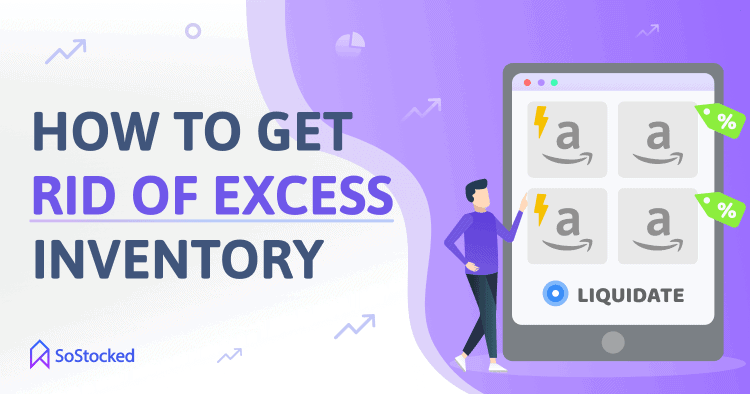
Eliminating excess inventory will not only minimize holding costs but also increase your sell-through rate and help you get your inventory back to optimal levels. Below are some of the best ways to do it:
Use Amazon’s FBA Liquidations Program
Amazon’s new liquidations program allows FBA sellers to recover a portion of the value from their excess inventory and minimize storage costs.
When you liquidate your inventory through this program, Amazon sends it to wholesale liquidation companies. In return, you’ll recover between 5% to 10% of a product’s average selling price, getting paid two to three months after your inventory is sent. Although you won’t be able to recover all of your costs, it’s better than having your excess units thrown away or sent back to you if you have no way to sell them on other channels.
Create Listings on Amazon Outlet
Amazon Outlet is another marketplace where you can put your excess stock on sale to increase your sell-through and reduce storage fees, thereby improving your cash flow.
This marketplace features:
- Outlet Sales for products sold at discounted rates
- Outlet Deals for promotional deals like Overstock Deals
Here are the steps to getting started:
- Check your eligibility.
- You must have a professional selling plan and an overall customer rating of 3.5 stars.
- Your product is at least 90 days old.
- You possess more than ten units of inventory on hand.
- Your product has a sales history.
- Your product is in new condition.
- Your product isn’t in Subscribe & Save and Lightning Deals.
- Your product hasn’t been on Outlet Deals in the past two months.
- Review your Outlet deal recommendations in the Manage Excess Inventory (MEI) tool.
- Create and submit outlet listings via the Create Outlet Deal section of the MEI page. Note that promotional deals must have a minimum 20% discount and may be featured on the Outlet page for a fixed period of 7 to 14 days
- Enter your target selling price in the Outlet Deal price box.
- Double-check your listing’s start and end dates, then click submit.
Creating a deal on Amazon Outlet doesn’t cost a thing, so it’s worth a try.
Take Part in Amazon Lightning Deals
A Lightning Deal or flash sale is a deep discount offer with limited time and quantity. Lightning deals appear on the “Today’s Deals” page and are only available for either 6 hours or until the listing runs out of stock, whichever comes first. It can be a profitable way of eliminating your excess units as the page is highly optimized for conversion. For example, the sale price is shown above a strikethrough price to draw the attention of potential customers. The page also indicates how much stock and time is left before the deal expires.
Like Amazon Outlet, Amazon also requires sellers to meet a list of criteria before taking part in Lightning Deals. These include:
- Your product must be eligible for Amazon Prime in all regions of the United States, including Puerto Rico, if your Lightning Deals are to take place in the U.S.
- Your product has a sales history and a product review rating of 3 stars.
- Your product must be in new condition.
- Your product must NOT be inappropriate, restricted, or offensive.
- If applicable, you must have enough stock for products with multiple variations (e.g., colors, sizes, shapes, etc.).
- Be compliant with Amazon’s Lightning Deal frequency policies.
- Your product must have a valid reference price and must be compliant with Amazon’s pricing policies.
Steps:
- Go to your Amazon Seller Central page, click the “Advertising” tab and go to the “Deals” menu.
- Click “Create a New Deal”.
- Pick an eligible product and enter the correct information for its Lightning Deal listing.
- Select your target date range.
- Enter your deal’s pricing and the number of units available for the deal.
- Review your deal and click submit.
Create an Amazon Removal or Disposal Order
Follow the steps below if you think your product sales aren’t enough to cover your Amazon storage costs or if you can get a better return on investment through other sales channels like eBay.
- Create a removal order. You can do this via the Manage Inventory page or Manage Excess Inventory page. Either way, submitting a removal order means you authorize Amazon to return the selected inventory to you.
- Via Manage Inventory – select from the “Edit” drop-down list and click “Create a removal order.”
- Via Manage Excess Inventory – this option only works for inventory that has been subject to long-term storage fees. If you’re qualified, select “Create removal.”
- Note that if your recommended removal list has multiple pages, you’ll have to make an individual removal order for each page.
- File a Disposal Order. This option means going through your removal order list and picking products to scrap without Amazon returning those units to you. Then, Amazon disposes of the selected products by either throwing them away or selling them off.
One thing to think about before going through this process is that Amazon removal orders don’t count as sales velocity. So if your goal is to free up space and improve your monthly velocity by moving your Amazon overstock inventory, I recommend doing a flash sale or selling via other online marketplaces that fulfill through Amazon instead. If you opt to do the latter, that should count as sales velocity in Amazon and potentially bump up restock limits.
Sell Excess Inventory to Liquidation Companies
One of the fastest ways to eliminate excess inventory is by selling them to liquidators, such as B-Stock and Excess2Sell. These liquidators purchase all kinds of inventory and resell the products for a much lower price.
While liquidation is the quickest way to sell surplus inventory, it’s not the most profitable. A liquidator usually buys your stock well below the selling price. There are also additional costs involved, like fees for sending your inventory to the excess stock liquidator. So weigh these pros and cons before selling your Amazon excess inventory to liquidators.
Adopt Inventory-Minded Marketing
Inventory-Minded Marketing is a new way of thinking of managing inventory. It is inventory management with marketing in mind, and it’s marketing with inventory management in mind. It encourages all your teams to work together to push both best sellers and slow sellers without overstocking or stocking out.
Yes, even slow-moving products have the potential to be top sellers if your inventory and marketing managers can figure out a strategy to get them back in the game. Your inventory team can inform the marketing team about the number of slow-moving products you’re keeping in FBA. The marketing team can then build out a flash sale plan based on the inventory manager’s demand forecasts, run a PPC campaign, and create a well-optimized listing to generate revenue.
The faster you turn that inventory into cash, the sooner you’ll clear out your storage space, free up capital, improve cash flow, and boost your ranking on that listing.
Inventory-minded marketing can also help you to prevent stockouts. SoStocked has a Future StockOuts Risk reporting tool that pulls up any product with a potential risk of stocking out. Using this tool can help you to keep a product’s stockout risk under control by spending less on ads or marketing efforts that could inadvertently cause a stockout. That said, your marketing team must be sent this report so that they can make timely adjustments to their strategy.
Pro Tip: Learn how you can incorporate inventory-minded marketing into your inventory management process.
Reduce Amazon Excess Inventory With SoStocked
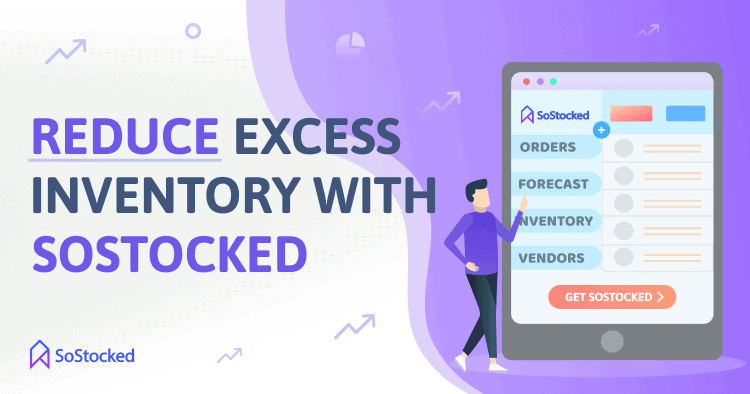
Accurately forecast demand and quickly identify slow sellers with our software’s:
Inventory Forecasting Feature
SoStocked boasts multiple inventory forecasting tools that help its users improve their forecasting accuracy. These include:
- Forecast modeling – Create a plan for up to 12 months’ worth of orders in advance based on customized models set on a per marketplace and SKU basis.
- Express order calculations – Automatically calculate how many units you need to ship via air freight, as well as how much stock to send via your standard freight transport.
- Customized velocity calculations – Our software uses multiple approaches to calculate your sales velocities to meet your unique needs.
- Advanced stockout calculations – Calculate stockouts based on your Amazon inventory levels and analyze significant decreases in your sales velocity. An extreme drop in your sales velocity may mean a listing suspension or some other anomaly that could throw off your data.
- Seasonality – Factor in seasonality when calculating reorders and forecasts for your seasonal products to avoid over-ordering or under-ordering.
Our Amazon inventory forecasting software also lets you fine-tune your calculations by allowing you to:
- Add Lightning Deals and email marketing plans into your calculations to accurately forecast the number of units you will need to be able to carry out your marketing strategies without encountering a stockout.
- Customize additional variables like Minimum Order Quantity, Minimum Transfer Quantity, Order Schedule, and Transfer Schedule.
- Set up a min-max restocking system to set buffer stocks and max stocks so you can work to avoid stocking out or over-stocking.
- Add trends to your velocity setting to forecast future growth based on past growth.
Overstock Dashboard and Liquidations Dashboard
Want to see which products have too much inventory on hand? Our Overstock Dashboard does precisely that. Knowing what excess stock you’re holding at all times is key to minimizing storage costs and improving sell-through rates, allowing you to scale more quickly by launching new products and putting more money into marketing.
Setting up a Liquidations Dashboard is ideal for identifying slow-moving and obsolete products costing you in storage fees and tied-up capital. This way, you can sell them to liquidators immediately or otherwise move them to bring your inventory levels back within optimal range.
Inventory Tagging Tool
Our inventory tagging tool is an effective way to label products based on your criteria so you can create reports, apply settings or otherwise filter them. Let’s say you may want to tag your surplus inventory as “Liquidate.” This method allows you to organize your inventory and view specific data by tags in the Forecast page so that you can apply changes specifically to the tagged products only, minimizing errors.
Slow-Selling ASINs Reporting Tool
Lower your Amazon overstock inventory risk by creating a report for slow-moving products. The data from our Slow-Selling ASINs report provides actionable insights that you need to take to manage your slower-moving inventory. These actions could be liquidating it or increasing its sell-through rate to somehow turn it into a more profitable asset.
Sync to Scale Feature
SoStocked has multiple reports that you can use to implement Inventory-Minded Marketing across your organization. Both your Inventory and Marketing teams should have access to Overstock, Liquidation, and Forecast Page reports to proactively take on the challenges that may arise due to overstocking. Try SoStocked today!
Turn Excess Inventory Into Profitable Products
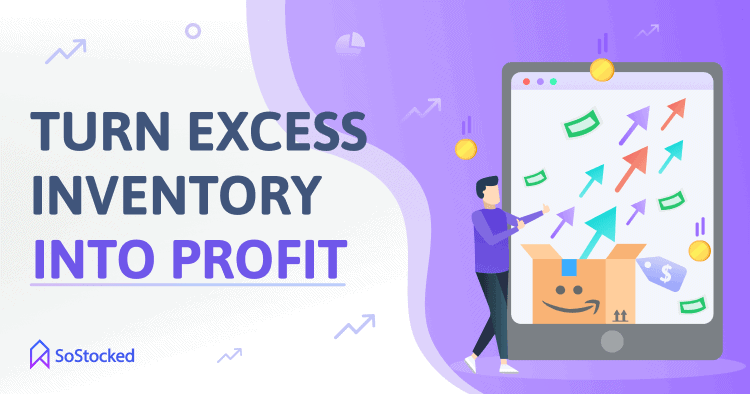
Managing your Amazon excess inventory requires maintaining a good balance between recovering what you can and cutting your losses. While it isn’t ideal to end up with 0 profits at all, or to lose money, you also don’t want to waste more time and resources on a product that will become more and more unprofitable when staying unsold for month after month.
The trick is to identify, monitor, and move slow-moving and overstocked products before they become obsolete. This way, you will still be able to recover some of your capital, improve your sell-through rate and rankings, and avoid storage costs. And if everything works out in your favor, you could turn a slow seller into another top-selling product.
Need more information?
- Send Message: We typically reply within 2 hours during office hours.
- Schedule Demo: Dive deeper into the nuances of our software with Chelsea.
- Join Live Upcoming Webinar: New to Amazon inventory management? Learn three inventory techniques you can implement right away.
 Get Started
Get Started